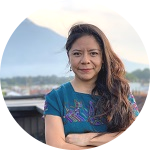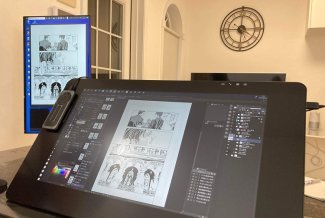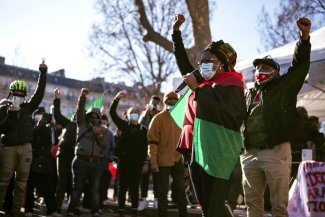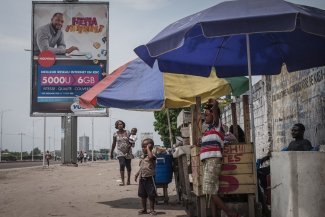Sixty-four-year-old Florinda Ramírez, a member of the Chortí people – descendants of the Mayan civilisation – cooks rice and beans over a low flame on a clay stove. On this Sunday in December, she discusses the family business of handmade textiles with four of her nine daughters, Flory Magalí (37), Oneyda (23), María Dominga (21) and Floridalma (16). The five women say they dream of becoming recognised entrepreneurs.
Flory Magalí is the most enthusiastic. She serves the tortillas for lunch and shows us a handmade tule fibre basket she has made. She also seems to be the most demanding on herself. “You have to look forward and take risks. You have to work to grow,” she says, with an air of determination.
In Chiquimula, part of the Dry Corridor – a vast area that has long been affected by an increase in extreme weather events and equally extreme poverty – most women live in rural areas and, according to data from Guatemala’s National Institute of Statistics (INE), 68 per cent of them are day labourers or subsistence farmers. Despite the conservative environment in which they live, many rural women are going beyond their traditional roles in the home and taking on additional roles as entrepreneurs and leaders in the outside world.
The eldest of the sisters looks out of the window, watching some of the women from the village hard at work carrying heavy loads on their backs. They live in the Escobillar settlement in the village of Oquén, in the municipality of Jocotán, in Chiquimula, western Guatemala. “This is where the famine took place,” she says. Chronic malnutrition is a serious problem for many of the people in this area. Chiquimula is the department with the second highest malnutrition rates in Guatemala, according to recent data from the government agency for food security.
Amidst this widespread hunger – exacerbated by the coronavirus health crisis and hurricanes Eta and Iota that struck one after the other during the same year – Flory and her family are looking for new ways to make money in 2021. The daily cost of the basic household food basket in the region is estimated at GTQ119.65 (€12.70, US$15.50)*.
Flory tells us that two years ago she set up a business selling handicrafts made from tule and fan palm fibre. This year, she, her mother and sisters have put together a catalogue that they promote on various social media sites.
They earn around GTQ150 (€16, US$19.40) a month from the products they sell. Flory also works outside the home now. She is a bilingual teacher, in Ch’orti’ Mayan – the majority Indigenous language in Chiquimula – and Spanish, in a public school. She is also the leader of a community of some 700 inhabitants.
Flory inherited the custom of weaving from her mother. Her father paid for his two sons to study, as Guatemala is a society where resources traditionally go to the male members of the family, but she paid for her own studies with the money she earned working and was the only one to graduate. She got married. She set up the business with her sisters, she explains, to finish off paying for her master’s degree and to set an example for them to follow. She would like to hire more women from her community, she says, but they cannot afford it. “People need a way to develop their own business and seed capital to invest in it,” she says, showing the decorative keyrings she finishes off making as we talk.

Flory Magalí and her mother (left), and younger sister Floridalma (right), founders of the Arte en mis Manos (Art in my Hands) enterprise, cook Sunday lunch at their home in Oquén (in the municipality of Jocotán, Chiquimula).
Flory Magalí sits in the hallway of her mother’s house, where she grew up. She looks at her graduation photo hanging on the wall and continues to pack the handicrafts with her sisters. She is a mother of two children, aged eight and five. Her third, who would have turned three in 2020, died at the age of two from fever and diarrhoea. She draws a breath, raises her hands to her head, clutching her hair, and recounts how she went to the health centre three times but the little girl was never admitted. The medicine she was prescribed was insufficient.

One of the Oahaca sisters, Floridalma, weaves tule fibre products to sell in the patio of her house, in the hamlet of Oquén – the cradle of the Chortí ethnic group. The family home has become the headquarters of the Arte en mis Manos business.
More than half of the population of Chiquimula is composed of women, according to the latest population and housing census of Guatemala (2018) – 52 per cent to be precise. Every year, between October and March, there is not a man to be seen in Chiquimula: they all migrate to coffee and sugar plantations far from their villages, some in Guatemala and others in the United States. Once again, it is usually the men who go away. And, still, it is not enough.
Large numbers of migrants from Chiquimula migrate to the United States – the equivalent of 45 per cent of the working population living in the department – as a direct consequence of the lack of access to a decent living.
The women are usually responsible for taking care of the household and raising their children, some with no other income than the remittances they receive from the United States. It is against this background that the Oahaca sisters worked towards becoming self-sufficient. The two generations of women are now covering their household bills.
Jessica’s castles
Eight kilometres from Oquén is the hamlet of La Mina. On the way there, at an altitude of 1,400 metres, we come across a group of women carrying receptacles filled with maize on their heads. They walk along the edge of a rocky dirt track, bordered by coffee plantations and plots of dry milpa. The landscape is crowned with isolated three-storey buildings on the top of the hill.
Jessica Méndez lives at the top of the mountain, in the hamlet of Agua Zarca. Her house is an hour and a half’s walk from Flory Magalí’s settlement. They do not know each other. Life in each community revolves around itself, except when the time comes to migrate to the sugar plantations on the south coast or to the farms in Honduras, or when people have to leave for good.

Jessica Méndez packs sacks of coffee to sell. She works with her mother and her niece at her home in the hamlet of La Mina (Jocotán, Chiquimula).
The 16-year-old packs the coffee for the new business set up by her sister Ana Cristina. In Guatemala, incorporating minors under the age of 18 into the labour force – most often on large coffee and sugar plantations – is permitted as of age 16, but minors can be employed as of age 14, with the permission of their parents or guardians. But some families, living in extreme poverty, have to involve their children in the harvest from an early age.
Jessica earns GTQ175 (€18.50, US$23) for every 100 kg delivered. The women working in agriculture in Guatemala only earn 10 per cent, overall, of the income earned from work in the sector. This is compounded by the fact that women find it difficult to access the labour market and the benefits derived from policies designed to ensure stable and sustainable food security. These are just some of the challenges Guatemala has to address as part of its commitment to meet the Sustainable Development Goals by 2030.
Jessica also works as a day labourer on private farms, where she earns GTQ40 (€4.20, US$5.20) a day. She tells us about the recent inauguration of one of the ‘castles’. That is what she calls what is known as ‘remittance architecture’ in Guatemala: large houses, built in very poor areas, with the money earned in the United States. Some of the houses remain unoccupied because the owners live in the US and send the money to build them to their relatives. Some are left half-built.

A house built with remittances in San Juan Ermita (Jocotán, Chiquimula).
The owner of the recently inaugurated ‘castle’, she tells us, lives in the United States. He came just to inaugurate his house, after being away for 18 years. A few metres up the road, there are another 30 or so other ‘castles’ in this remote village of Jocotán, she says.
Jessica wants to be a police officer and a social worker. It is still wishful thinking at this stage, as she has not yet completed her basic education, although she is still trying to get there, at the same time as working on the plot of land her family rents from a landowner. It is dusk and she quickly jumps into a small pool she has made to collect water. She climbs over rocks to an area she calls ‘el campanario’ (the bell tower). It is a huge rock formation between milpa and bean fields, overlooking the entire valley of the Dry Corridor. She throws a stone and a bell-like sound echoes from below. It is her favourite spot. She often spends time here in the early morning, before heading to the harvest.

Jessica Méndez on the corn and bean plot she works on, in front of the rocks she calls ‘the bell tower’. Behind her lies the landscape of the Dry Corridor. La Mina, in Jocotán, Chiquimula.
Jessica walks home as the sun goes down. Her sister, Ana Cristina, the coffee sales businesswoman, has just arrived. The twenty-nine-year-old is the eldest of 11 siblings. Twenty-one families live on this land. The women from this household are the most visible.
Ana Cristina makes a few calls whilst giving her three-year-old son his dinner. She partnered with local suppliers in October 2019 to sell coffee. Jessica is outside, packing sacks of coffee. Ana Cristina earns GTQ230 (€24.40, US$30) a month from her coffee sales.

Ana Cristina Méndez, one of the heads of the family, who has started her own coffee selling business. She harvests coffee on her own plot in the hamlet of La Mina (Jocotán, Chiquimula).
Ana Cristina’s husband sends her around GTQ2500 (€265, US$324) a month from the US. Over half of it goes towards paying the ‘coyote’ who took her husband to the north three years ago. They still have almost GTQ30,000 (€3,179, US$3,886) left to pay. She uses another part to pay for the works to extend her house, which can hardly be considered a ‘castle’, she says, and is left with around €33 to buy food for the month for her two children, her parents, her younger sisters and her nieces and nephews. She brushes her hair as she tells us she has found a new job, starting in 2021, as a secretary for a local business in Jocotán.
According to the report on rural workers in Guatemala, Trabajadores Rurales en Guatemala, published by the Association for Research and Social Studies (ASIES), if a regional GDP growth rate of three per cent – on average – were maintained, it would take until 2023 to reach the GDP of 2019, a conclusion also reached by ECLAC and the ILO. That is why the United Nations is insisting on the need for active macroeconomic policies and sectoral policies that promote sustainable development with employment.
Tierra Viva: the women leaders of Barbasco
It is half past six in the morning and the sun has barely risen, but there is already a glimpse of humidity on the landscape, a rarity in this arid region. A group of 27 people, mostly women, of all ages, are hoeing the soil on a plot of land they rent collectively, thanks to the leadership and entrepreneurial spirit of the women in the community.
The plot is deep in the Barbasco settlement of the village of Talquetzal, in Camotán, another municipality of Chiquimula, a two-and-a-half-hour drive from La Mina. In Chiquimula, only 42 per cent of farmers own their land, according to a recent mapping of the labour situation in the department by ASIES.
The level of organisation in the community led by women is visible. The leadership group was elected in community assemblies on nutritional surveillance. In other words, the people of the village decided who were the best people to cultivate the basic grains grown for consumption and to promote a healthy diet. Organisations such as Action Against Hunger provide advice and support for some of the processes to improve local health conditions. The women, and a few men, do voluntary work on the rocky and steep plots to ensure food for the next season.

Women of different ages clear the land and pick the cobs of red corn from the plants that have sprouted there.
The roads in this already quite remote settlement have been cut off, the houses are cracked and the land has been destroyed by recent natural disasters. Although there is a relief fund for emergencies of this kind, government support has not been forthcoming for some families, according to Saturnina Salguero, one of the community leaders in Barbasco.
The 55-year-old is a dynamic person. She has nine daughters and is a family counsellor. She points to the family and community plots that she works on. Then she puts seeds for the next harvest in the dried milpa leaves that hang in the kitchen.
She accompanies a group of women who travel on foot every day, with hoes and machetes on their shoulders. With a firm and determined voice, she has been sharing her knowledge for 12 years. “We know that only men have been working [outside the home], but we’re doing it too. Now we women have to found ways of helping our families, but we are organised,” she says, as she walks in front of the group of women she leads.

Saturnina Salguero in the kitchen of her home after returning from working the land (in Talquetzal, in the municipality of Camotán, in Chiquimula).
Mrs Salguero, a woman with a tough exterior, has also been a point of reference for many of the male community leaders when it comes to decision-making. Everyone knows her and greets her as she moves around the community. She earns just €4 a day as a labourer, a job she does from time to time. A male day labourer earns around €6.
Mrs Salguero works in the fields with her 75-year-old husband and lives with five of her daughters, whom she supports. Despite their poverty, as she describes it, she managed to get them through primary school. Seventy-four per cent of the population in Chiquimula has not attended school and the literacy rate is higher among males, according to the National Statistics Institute (INE).
Four of her daughters have already married and live far away. The others work in the area around her community. “After our maize and bean harvest, we have to see where to start working and earning money again,” she says. She walks barefoot on the soil and leans on the hoe she carries. She looks into the distance and predicts, out loud: “There’s a drought coming.”
Back home, she eats a plate of tortillas, beans and some herbs from her garden. She walks through her courtyard and points to the community school. It is time for her to go and do her counselling work, she says. She engages with families who have young children and advises them of the benefits of working in education and health, especially in times of crisis.

Women of different ages, carrying farming tools, do voluntary and collective work on plots of land in Talquetzal (in the Camotán municipality of Chiquimula). No government support was received after the natural disasters of 2020.
Saturnina Salguero, as a community leader and with her many years of experience, could be an example for Jessica Méndez, from La Mina. But they do not know each other. They do not know each other, nor do they know Flory Oahaca, the handicraft entrepreneur from Oquén, who often thinks that if she were to receive support for training, she could also act as an entrepreneurial example for young people from other villages.
They live quite close to each other, they are from the same Chortí territory, but they are still exceptional cases.
For now, most women in Chiquimula are far from being like Saturnina, the sisters, Jessica and Ana Cristina, or Flory and her family. They usually carry the responsibility for raising the children and feeding and caring for their families. As housewives, they have no time for themselves or for paid work.











